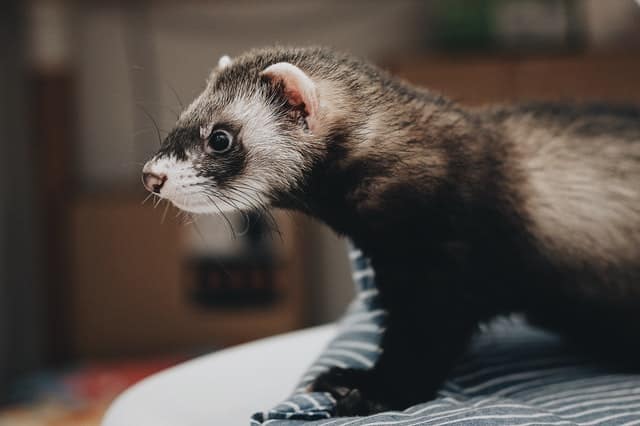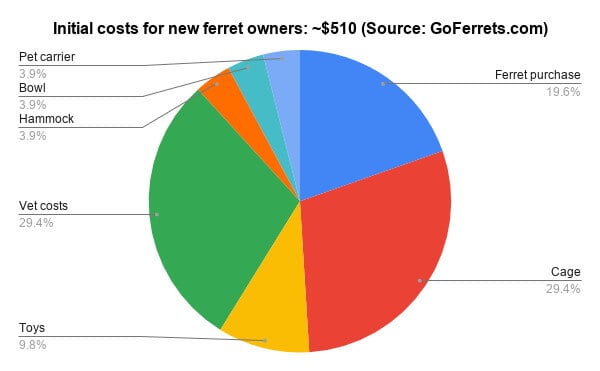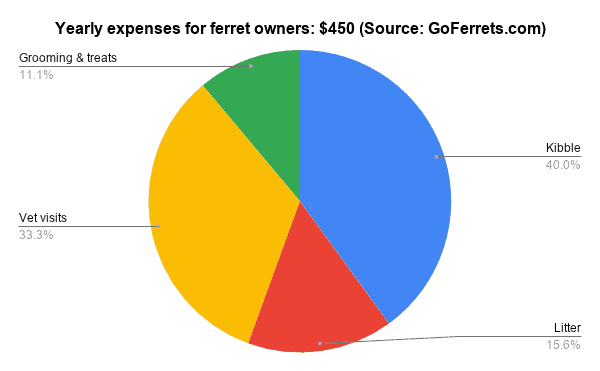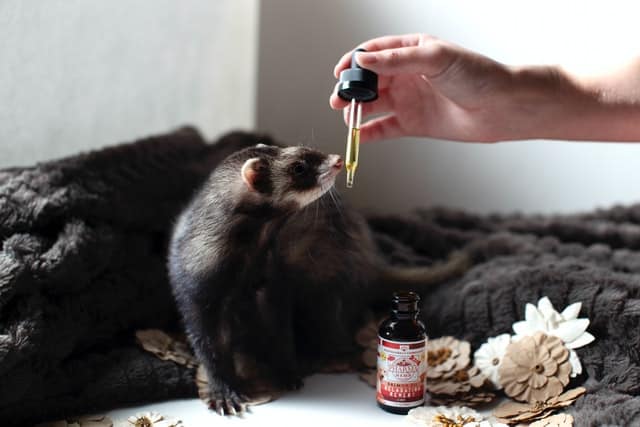Looking for a cute pet, which is sociable, playful and curious? Keeping ferrets as pets is possible, but it’s not nearly as common as other types of tamed animals. With their share of pros and cons, which we will discuss below, this type of animal will bring the owner a lot of joy, particularly if it’s well trained.

The Ferret – What is it and what does it look like
A ferret is a type of polecat, a mammal which is typically found in Europe, part of the same family of animals as the weasel. While a weasel is a wild animal which is not recommended to be kept as a pet, a ferret is the domesticated version and it is quite common in households all over the world.
Official name: Mustela Putorius Furo
Size: It has an average length of 20 in (51 cm), out of which the tail measures 5 in (13 cm).
Weight: the ferret weighs very little, typically ranging between 1.5 and 4.4 pounds (0.7 to 2 kg).
Most of that difference in weight comes from the male vs female comparison, with the former being considerably larger.
Lifespan: 7-10 years.
Quick: Pros & Cons to owning a pet ferret
Pros
- Adorable
- Playful
- Curious and intelligent (train them to do tricks)
- Small and easy to handle
- Easy to exercise
- Quiet animals
- Lots of energy
Cons
- The musky smell
- Nipping and possibly biting
- Don’t do well around other pets
- Home needs to be ferret-proofed.
- Not recommended around small children.
- Social animal, needs lots of attention or a second ferret as companion.
Types of domestic ferrets – breed and colors
There is considerable diversity when it comes to the types of ferrets that you’re going to find on the market.
More often than not, the difference will come from the color or pattern of the fur coat.
However, there are several variants of ferrets which are basically different breeds. According to their size, we have:
- Standard
- Whippet
- Bull (Bulldog)
If we look at the fur length, then we have options like:
- Short fur (standard).
- Long fur (with undercoat)
- Angora (long fur, without undercoat)
As for different colors and patterns that can be found, the typical ones are:
- Albino (all white)
- Black Sable
- Blaze
- Champagne
- Chocolate
- Cinnamon
- Dalmatian
- Heavy Silver/Pewter
- Panda
- Regular Sable
- Light pattern
- Medium pattern
- Siamese
- Striped White
- DEW – Dark-eyed White
More info here: 26 Different Types of Ferrets – By Color, Coat Length and Size
Keeping ferrets as pets – Is it a good idea?
The ferret is very intelligent, active and social, so it’s recommended that you buy them in pairs (one male and one female, never two males). It requires training, because nipping is something it does while playing, and it needs to be taught that it’s not OK to do it.
It is not a pet to have around small children, so wait until you have at least teenagers, to introduce them in your family.
To answer the question, I’d say that it depends. You have to ask yourself a couple of questions first.
Can I give a pair of ferrets all the attention they require?
These are social animals and they’re active, so they don’t do well if they’re closed in cages all the time.
Will it have to interact with small children?
If you have small children in your family, even up to 12 years of age, then having a ferret around them is not typically a good idea.
Ferrets nip and may bite if mishandled/hit by a small child. Nipping behavior can be trained out of it, but the recommendation to only have it in families with children aged 12+ remains.
Is it recommended to first-time pet owners?
No, it’s going to require more attention and experience than other types of pets, so if you’ve never had one before, it might be too much for you.
Is it a good idea though?
Yes, provided that you can offer them the attention they need, so they don’t become destructive, ferrets can be great companions to have around. They love to play, they’re fun to have around and they’re adorable.
Just make sure you adapt to their needs and you give them the environment, diet and exercise that they require.
What is it like to own a ferret?
Having a ferret as a pet can be a wonderful experience, but you have to work for it a bit first.
They need to be handled properly, socialized and trained, and you need to do it early on.
Luckily, training them is easy, and you can get them to use a litter box, not to nip or be aggressive, and they can make great pets in that case.
If you have only one ferret, then you need to give it a lot of attention, several hours of play time each day typically, as it’s a social animal (lives in colonies in the wild).
Ideally, you want a pair, male and female, so that they can play with each other.
Owning a ferret is more work than it would be to have a cat or dog, so if you can’t give one enough attention, it’s better if you don’t get one.
You need to give them a couple of hours of attention, supervising them as they play around the house. Keeping them only in a cage all the time is not really possible.
They’re highly active and they do all sorts of antics, entertaining the owner, so it’s a pet that will make you smile often.
All things considered, it’s fun having a ferret as a pet, but it can also be time intensive and expensive. Generally it’s not a good idea for first-time pet owners.
Where do you keep a ferret? In a cage.
You’ve done all the research, and you’re looking to buy one or two of these cute critters. Well, now it’s time to get your home ready for their arrival.
You absolutely need a cage in which you can keep them while you’re not around to supervise, because they will get into trouble otherwise. That being said, you need to give it plenty of exercise and freedom each day, or they get bored and destructive.
Even if you get them as babies, you should buy an adult-sized cage, because they grow quickly, and in just a matter of months they will reach their adult size.
The typical ferret cage:
- is built for 1 or more ferrets, so buy an appropriate size.
- will have 2 levels and ramps, so they can climb
- there will be an area where you can put in a hammock.
- will have a hut area where the ferret can sleep in the dark.
- will have a litter box.
- may have removable trays and shelves, to be easy to clean.
Ferret-proofing a home, a few tips
Extremely curious, ferrets are flexible and small enough that it can be a real issue keeping them out of harm, or from destroying things in your house.
Since they need to be left out of their cage, to exercise and explore several hours each day, there is plenty of time for them to get into trouble.
That’s where ferret-proofing comes in, an activity that you have to keep doing for as long as they’re around.
You will not be able to think of everything the first time around, so as you discover new ways in which they get into trouble, you keep improving your home.
Ideally, you want to keep an eye on your ferret while he’s out of the cage, and pay attention to the things he’s trying to get into. You will be able to secure those places before they can break through.
And below, you have several tips on ferret-proofing a home, which will help you out.
- Secure all potential exit routes (doors, windows). If you usually keep windows open, make sure you close them before letting the ferret out of the cage. The same goes for toilets.
- Ferret-proof at least one room where you can let it out of the cage for a couple of hours. You might not be able to do it with a big house or apartment, but you can usually do it for a single room.
- Secure appliances. Ferrets can get underneath them and inside, so you want to block their access.
- Check and reinforce the underside of your furniture, including reclining chairs, couches and beds, using a heavy fabric there.
- Find and block small spaces, especially if they can get into walls or into other areas this way (air vents, plumbing, cupboards).
- Anything that would be dangerous for a small child, would be something to watch out for in the ferret’s case as well (keep cleaning supplies locked, plants in the room might be burrowed in, unsecured large objects may fall on them, garbage will be explored, etc).
How much daily exercise does it need?
The ferret is not the type of animal to just leave alone and locked in a cage all day long.
It’s social and has a lot of energy, and you need to interact with it between 2 and 4 hours daily.
Leave it out of its cage, in a room that is completely ferret-proof. They can go back inside and drink water or eat something, and they may even use the litter box there.
One way to make sure it’s not going to be as bored or as dependent on your presence, is to have 2-3 ferrets together.
They will do well together and they will not become destructive when their owner can’t give them all the attention they require otherwise.
The requirements for 2-4 hours of exercise out of the cage will remain though.
Does it smell?
Ferrets have a specific earthy and musky smell, which is going to accompany them throughout their lives.
The musky smell will always be there, but it’s going to lessen as a result of the removal of their anal glands. It’s typically done before you even buy it, if you get the ferret from a pet shop.
With their anal glands present, they are able to release pungent secretions when they think they’re in danger or when they’re looking to mark their territory.
Neutering ferrets will also contribute and will make them smell less, since hormones are contributing to this issue.
Baths help, but not that much: bathing is not recommended to be done often, and it doesn’t help as much as you’d think anyway. Their skin has scent glands which will keep that musky smell around. If you do it, use special shampoo designed for ferrets or kittens.
Ear cleaning: it’s something that you can work on, removing the smelly wax which builds up easily. You can use special ear cleaning solutions for this.
More info on grooming ferrets.
How much does it cost to own a ferret?
Buying the ferret is not the issue, it’s a fairly cheap animal to get, usually somewhere around $50 to $100 for the common variants. It might go up to $250, if you’re looking for a rarer combination of colors.
The initial costs should include the equipment needed to house it and feed it, so that’s another $100 to $200 that you could be spending on a decent cage, food and bowls. The vaccines and the vet will set you back another $100 or more.
Once you have all the equipment in place, the costs are not high, at least if the vet doesn’t get involved because of health issues (especially in old age).
Initial costs of ferret ownership ($300 to $800):

- initial purchase: $50-$250
- a decent cage: $100-$300 (this one’s good)
- small pet carrier for vet visits: $20
- bowl: $20
- hammock for cage: $20
- neutering or spaying ($150 to $300) if required (may already be done when bought)
- leash and various toys: $50
Ongoing costs ($400 to $500+ per year):

- commercial kibble: $10-$15 per month
- litter: $5-$10 per month
- yearly vaccines/vet visits: $150-$200
- special shampoo, treats and other small expenses: $50
- unscheduled health issues and emergencies (it depends)
Ferret Breeding
Want to get into ferret breeding as well? We have some resources that will give you basic info on what you should do, to get it right.
- When Is Ferret Breeding Season?
- Ferret Breeding – How To Do It At Home
- How to Take Care of a Baby Ferret
A short history
 Though it might not be common knowledge these days, the ferret has been around as a pet for over 2,000 years. While in our times we see it mostly as a pet that’s nice to have around, initially it had a much more useful role for those that tamed it.
Though it might not be common knowledge these days, the ferret has been around as a pet for over 2,000 years. While in our times we see it mostly as a pet that’s nice to have around, initially it had a much more useful role for those that tamed it.
Its role back then was as a hunter, used to catch rabbits for its owners.
As it happened with plenty of other tamed animals, especially dogs, this is still true today for some of them, but mostly they’re kept around as pets.

